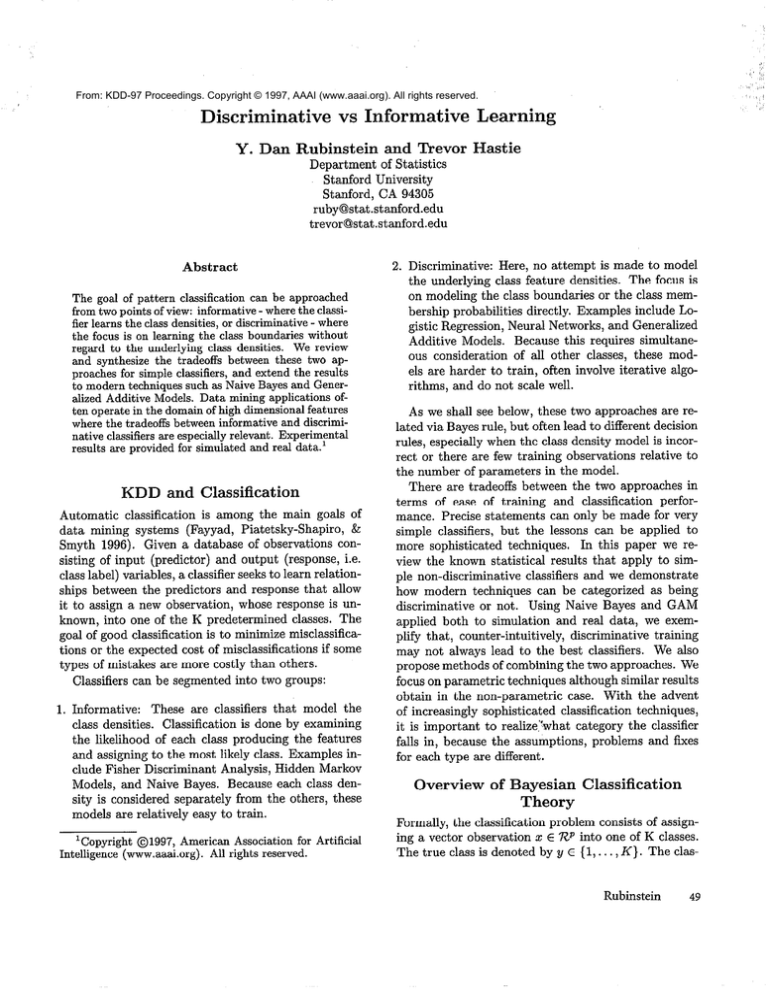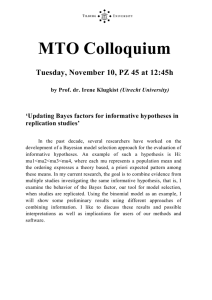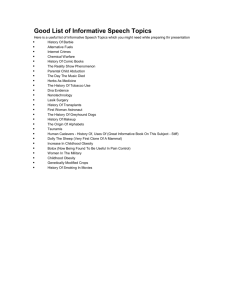
.,
LI <”
.I’
From: KDD-97 Proceedings. Copyright © 1997, AAAI (www.aaai.org). All rights reserved.
Discriminative
vs Informative
Y. Dan Rubinstein
‘,
Learning
and Trevor
Hastie
Department of Statistics
Stanford University
Stanford, CA 94305
ruby@stat.stanford.edu
trevor@stat.stanford.edu
Abstract
The goal of pattern classification can be approached
from two points of view: informative - where the classifier learns the class densities, or discriminative - where
the focus is on learning the class boundaries without
regard to the underlying class densities. We review
and synthesize the tradeoffs between these two approaches for simple classifiers, and extend the results
to modern techniques such as Naive Bayes and Generalized Additive Models. Data mining applications ofI^_
-----A.-:- 1u LL2--.-s.. ,cL:,L
,l:m,no:,nn, &..,+..ron
IJeLluyaraw
IJUI:U”Lllcz,U
“I Lup uLLlL~~DI”II(III
IGi(lr”UIG.3
where the tradeoffs between informative and discriminative classifiers are especially relevant. Experimental
results are provided for simulated and real data.’
2. Discriminative: Here, no attempt is made to model
the underlying class feature densities. The focus is
on modeling the class boundaries or the class membership probabilities directly. Examples include Logistic Regression,Neural Networks, and Generalized
Additive
Models.
Because this requires simultane-
ous consideration of all other classes, these models are harder to train, often involve iterative algorithms, and do not scale well.
lated via Bayes rule, but often lead to different decision
rules, especially when the class density model is incorrect or there are few training observations relative to
the number of parameters in the model.
KDD
There are tradeoffs between the two approaches in
terms of ease of training and classification perfor-
and Classification
Automatic classification is among the main goals of
data mining systems (Fayyad, Piatetsky-Shapiro, &
Smyth 1996). Given a database of observations consisting of input (predictor) and output (response, i.e.
class label) variables, a classifier seeksto learn relationships between the predictors and response that allow
it to assign a new observation, whose response is un-
mance. Precise statements can only be made for very
known, into one of the K predetermined
applied both to simulation
classes. The
goal of good classification is to minimize misclassifications or the expected cost of misclassifications if some
types of mistakes are more costly than others.
Classifiers can be segmented into two groups:
1. Informative:
These are classifiers that model the
~lslaa
laraifirn.t.inn
“A~“” rlancit;cl~
UUAIYAYA”“. f’
d,,,,...,,.,,.-
in
-- done
hv
IJ nun.mininp
---I---------o
the likelihood of each class producing the features
and assigning to the most likely class. Examples include Fisher Discriminant Analysis, Hidden Markov
Models, and Naive Bayes. Because each class density is considered separately from the others, these
models are relatively easy to train.
‘Copyright 01997, American Association for Artificial
Intelligence (www,aaai.org). All rights reserved.
simple classifiers, but the lessons can be applied to
more sophisticated techniques. In this paper we review the known statistical results that apply to simple non-discriminative
classifiers and we demonstrate
how modern techniques can be categorized as being
discriminative or not. Using Naive Bayes and GAM
and real data, we exem-
plify that, counter-intuitively, discriminative training
may not always lead to the best classifiers. We also
propose methods of combining the two approaches. We
focus on parametric techniques although similar results
obtain in the non-parametric case. With the advent
of increasingly sophisticated classification techniques,
:c
Ib
:n :-s.r\rtnn+
13 ML~“llJallb
+n
IJ”
znnl:n,,‘*z.,ha+
lGall*G,
NyIIcb”
nqtomrr,..,
bauzEj”LJ
th,,
~1nnn;fic.r
“A&G CIIclJUUIII~L
falls in, because the assumptions, problems and fixes
for each type are different.
Overview
of Bayesian
Theory
Classification
Formally, the classification problem consists of assign-
ing a vector observation 2 E 7V into one of K classes.
The true class is denoted by y E { 1, . . . , K}. The clasRubinstein
49
sifier is a mapping that assigns class labels to observations: y : z + (1,. . . , K}. There is also a cost matrix
c(r,s), T, s = 1,. . .) K which describes the cost associated with misclassifying a member of class-r to class-s.
A special case is O/l loss, c(r, s) = 1 - c$.,~= 1 if T # s
and 0 otherwise.
Underlying the observations is a true joint density
P(x, y) = P(ylz)P(z) = P(zly)P(y) which is unknown.
The goal is to minimize the total cost of errors, known
as the overall risk and this is achieved by the Bayes
classifier (Duda & Hart. 1973)
y(x)
=
=
rnp- lc
ckm)P(Y = 4x1
nZ=l
m,ax-lP(Y = Iclx) (O/l loss).
X
(2)
.
This discriminant preserves the ordering of the class
posterior probabilities and can be used instead of them
for classification.
Informative
Classification
Rather than estimate the class posteriors P(ylx) directly, the class densities p(xlg) and priors p(y) are
estimated. The operative equation here is Bayes rule,
which gives the class posteriors in terms of the class
densities and priors
P(Y = $4 =
PblY = WP(Y = k)
c: P(4Y = rn>P(Y = m> *
Typically some model is chosen for the class densities, for example gaussian, Pe(XlY = k) = n/(x; pk, C)
(heree={pi ,..., pK,7rr ,..., 7rK,C}),andthemodel
parameters are estimated from the data by maximizing
the full log likelihood
oMLE
50
=
KDD-97
meaX -l~hWe(xi,Yi)
i
n-y-l
~logPe(xilyi)
i
+ lOWe(
For the gaussian case this yields the well known
estimates ?k = nk/n,fik = L%k= & cyiCIE X4,x =
i Cf Cyizk(xi - Zk)(xi - &)’ where nk is the number of observations from class Ic and n = Cf nk. The
discriminant functions are
xk (x> =
(log 2
- ;(Pk + PK)WPk
- /.a)) +
(1)
For O/l loss this reduces to classifying x to the class Ic
for which the class posterior probability P(y = IcIx) is
maximum.
In practice, the true density P(x, y) is unknown and
all that is available is a set of training observations
(xi,yi) for i = 1,. . . ,n. Many classification techniques seek to estimate the class posterior probabilities
P(y = klx), since we see in (2) that optimal classification can be achieved if these are known perfectly (for a
discussion on the relationship between class posteriors
and neural net outputs see (Ney 1995)).
For convenience in what follows, we will make use of
the discriminant function
X,(x) = log pq(yy_=;;;
=
and are linear in x. Note that while Kp+P(p + 1)/2 +
(K - 1) parameters are estimated, the discriminants
involve only (K - l)(p + 1) parameters.
The important points with informative training are
1. A model PO(XIY) is assumed for the class densities.
2. The parameters are obtained by maximizing the full
log likelihood log PO(x: Y) = logv-“\“I
nn(ulz)sn
,a”\ (5).I
3. A decision boundary is induced, and the model parameters may appear in a way that reduces the effective number of parameters in the discriminant.
Discriminative
Classification
The discriminative approach models the class posteriors and hence the discriminants directly. The discriminative approach is more flexible with regard to the class
densities it is capable of modeling. By only restricting the discriminant &,(X) = log[p(y = klz)/P(y =
Klx>l= lwM4y = ~)P(Y= WP(~Y= KMy = K)l
we are capable of modeling any class densities that are
exponential ‘Ws” of each other
P(Y = K)
P(X[Y = k) = exk(“)p(xly = K) p(y = k) .
In particular, the informative model, as regards the
class densities, is seen to be a special instance of
the more general discriminative model. The example
above was a special case with a gaussian as the “carrier” density
p(xly = k) = N(x; pi, C)ep~+ob’s (z)
while the corresponding discriminative model allows
any carrier density
~(43= k) = fdx; e>e
so long as the discriminant is linear.
Parameter estimation in the discriminative case is
cnrr;nrl
nrrt
lna
cI.zJ,II‘~U
“L&Uh-7
“J mcavimininrr
IILu,‘u”I’Y”‘~ thn
“IA”rr-mrlitinn
U”IIU1”L”A~
L”b 1ilmlihnnA
L~l.Y~~~L”“U
= mop -l
sippde
SWP.AIIthrmeh
o-- -..--=
------o-
the
---- data: The
-__- diqcriminativc!
-_L- ________
21-. - anIr
preach requires an iterative optimization via a gradient
descent of the conditional likelihood.
7L
9DISCR
The informative approach requires estimating class
means and a pooled covariance which requires only a
~logPe(YiIxi).
i
On the one hand, maximizing the conditional likelihood is a natural thing to do because it is directly focused on the class posteriors p(ylz) which is all that is
required in order to classify well. However, it is ignoring part of the data, namely, the marginal distribution
p(z). Compare to the full likelihood case where each
observation contributes p(~:, y) = p(ylz)p(z). The discriminative approach, which uses only the first term
on the right side, throws away the information in the
marginal density of x. Thus, if the class density model
is correct, the discriminative approach ignores useful
information. However, ignoring the class models may
be good if they are incorrect. The table below summarizes the main comparisons between the two approaches.
Objective
Discriminative
Informative
log
Full log likelihood Conditional
Function
xi logpe(zi, y;)
Figure 1: Class densities for 3 cases of simulation
data. The class boundaries derived from many (10000)
training observations for Normal Discriminant Analysis (LDA) and Logistic Regression (LOGREG) are
shown: points to the left of the boundary are classified
to class 1.
likelihood
JJ logPe(Yil~i)
densities Discriminant
Class
functions XI,(~)
p(zly = L)
“Hard”
“Easy”
Model
Assumptions
Parameter
Estimation
Advantages
efficient More flexible, roMore
if model correct, bust
because
borrows strength
fewer
1 from p(z)
1 assumptions
Disadvantages 1 Bias if model is 1 May also be biI
I- _...._^^I
IuC”I-recb.
I
.-&d
T --^..-lgu”ltT3
:,
111-
I
formLion in w(x)
Logistic Regression vs Linear
Discriminant
Analysis
A lot of insight can be gained from examining the
two class case where the class densities are assumed
to be Gaussian p~(zly = k) = N(,t~k, C) [z] =
d&
exp -(+(x - #)‘C-l
(X - pk)) with priors
PS(Y= k) =m.
When the popuiations are gaussian, informative
classification is more efficient than discriminative, ie
fewer training observations are required or for a fixed
number of training observations, better classification
is obtained (Efron 1975; O’Neill 1980; Ruiz-Velasco
1991). Even when the class densities are not gaussian
there are circumstances - such as when the classesare
well separated - when informative training does about
as well as discriminative (Byth & McLachlan 1980).
iments. Case 3 is a gaussian class case for which we expect LDA to do better than LOGREG when the models are learned using training data. For each case, 100
training sets with 5 observations per class, i.e. p(y =
1) = p(y = 2) = l/2, were drawn according to the class
densities pictured. LDA and LOGREG classifiers were
trained for each set and the exact probability of error
was computed using integration over a grid P(error) =
The table below provides error rates using the two
procedures. Each column corresponds to a different
density case as depicted in figure 1. The first two rows
are ‘<best”in the sensethat the model is trained using
the complete density, not a sample of training observations. The remaining
rows are averages and standard
errors of the error rates across 100 training sets, each
of which contained 5 observations per class.
Rubinstein
51
I case
LDA - best
LOGREG - best
LDA
SECLDA)
LO-GREG
SE(LOGREG)
II
21
31
28.1 8.6
6.7
8.8
3.1
6.7
25.2
9.6
7.6
0.47 0.61 0.12
.“2.6 4.1
8.1
0.94 0.17 0.27
As expected, LDA did better than LOGREG when
the classeswere gaussian (case3). An interesting result
in case 1 is that LDA does significantly better (25.2%
vs 28.1%) when it does not know the true distributions. In this case, it is because the true distribution
is highly non-gaussian. When the number of observations are few relative to their dimensionality, informative methods may do surprisingly well even when
the model is incorrect (see also the GAM/Naive Bayes
example below).
StatLog data
The StatLog experiments compared several classification techniques on various datasets. For most of the
datasets, logistic discrimination did better than the
corresponding informative approach of LDA (Michie,
Spiegelhalter, & Taylor 1994). However, there were
several cases, such as the chromosome dataset, in
which LDA did better than logistic discrimination. For
these cases, the informative model apparently makes
use of important information in the marginal density
log ratio of class posteriors is additive in each of the
predictors zj, j = l,, . . ,p
log ‘(’ = ‘lx) = 2 fk,j(xj) + constb.
P(Y = Klx)
j
1 Naive Bayes classifiers are a specialized
case of GAM.
Proof It suffices to show that the induced discriminant
is log additive.
Theorem
log P(Y = Vx) =
P(Y = 04
=
log PMY = k)P(Y = ICI
P(ZlY = K)P(Y = K)
l%P(XlY = k) - logp(xly
= K) +
l%KY = UP(Y = K)l
1
&lhj(xj)
iMY
=
- SK,j(Xjcj)l+
= k)/P(Y = WI
f: fk,j(xj) +
constk
j
0
In the comparisons to follow, we ensure that the same
representations are possible for both procedures. In
particular, for the informative case, we model the class
densities with logspline densities which imply an additive spline discriminant
P(Xc>*
Naive Bayes and GAM
Naive Bayes classifiers are a specialized form of a
Bayesian network (John & Langley 1995; Langley &
Sage 1994) and fall into the informative category of
classifiers. The class densities assume independence
among the predictors
PblY = ICI =
* logp(xly = k)
fiP(dY
j
= ICI
=
~logP(xjIY
=
g9r;,(z,),
j
T.nndc,~
anrl w-v
BTP nnim
fnr thic!
T-PRE~~ --‘
b...“.
-zu
1-w.. v A..&
YA&.Y^“W”V&..
= k)
OTnhn & ,,ngT
\“...A”
ley 1995) considered class densities tha.t are products
of univariate gaussians as well as “flexible” gaussian
kernel densities.
The corresponding discriminative procedure is
known as a Generalized Additive Model (GAM)
(Hastie & Tibshirani 1990). GAM’s assume that the
52
KDD-97
O,(X) =
&Oj,nB,(2)
j
where B is a natural cubic spline basis.
Logspline simulation
study
For the simulation study shown in figure 2, the discriminant was taken to be an additive spline with 5
uniformly spaced fixed knots. Class 1 is a complicated
mixture density (the outer ring), and class 2 (the two
mounds in the middle) is the exponential tilt (using
the logspline discriminant) of class 1. The Naive Bayes
classifier assumesa logspline density (see (Stone et al.
to appear)) separately in each dimension and in each
class. Asymptotically, the GAM classifier achieves the
Ravm
OFmr AWYV
rate \,.A,,“,
17 ‘F!Z,\ Ylll””
~inre
YWJV”
VL-VL
t-ho
cliwr;minmt
“ALU tnm
YLuv UI”UIIIAIA~LLuII”
is log additive by construction. Asymptotically, the
Naive Bayes (NB) classifier does worse (9.0%) than
GAM, since the class densities are not a product form.
However, when only a finite sample of training observations is available, the Naive Bayes classifier does surprisingly well (this behavior has been noted by Langley
References
Byth, K., and McLachlan, G. J. 1980. Logistic regression compared to normal discrimination for nonnormal populations. The Australian Journal of Statistics 22:188-196.
Duda, R. O., and Hart., P. E. 1973. Pattern classijication and scene analysis. Wiley.
Efron, B. 1975. The efficiency of logistic regression
compared to normal discriminant analysis. Journal
of the American Statistical Association 70(352):892898.
L
-5
0
traindata[, -l][.i]
5
Fayyad, U. M.; Piatetsky-Shapiro, G.; and Smyth, P.
1996. From data mining to knowledge discovery: An
overview. In Advances in Knowledge Discovery and
Data Mining. The Mit Press. 1-31.
RYedman, J. 1996. on bias, VXimCe, O/l-iOSS 2nd
the curse of dimensionality. Technical report,, Dept.
of Statistics, Stanford University.
(Langley & Sage1994)). In simulation experiments, 25
training sets each containing 25 observations from each
class were used to train both NB and GAM classifiers.
The averageerror rates were 11.1% for NB and 11.4%
for GAM with standard errors of 0.05 % and 0.06% respectively. Here then is an instance where informative
training actually does slightly better than discriminative training, even though the discriminative model is
correct and the informative one is not!
Conclusion
Recently, Friedman (Friedman 1996) has shown that
when it comes to classification, bias in the class posteriors is not so critical because of the discretization of
the assignment rule. So even if the class density model
is incorrect, i.e. biased, it may yet get the upper hand
especially if it has lower variance estimates of the ciass
posteriors across training sets.
It is best to use an informative approach if confidencein the model correctnessis high. This suggestsa
promising way of combining the two approaches: partition the feature space into two. Train an informative
model on those dimensions for which it seemscorrect,
and a discriminative model on the others. Experimental results on this approach are forthcoming. We are
also investigating other techniques of combining the
+...r.
l!W”w...nnnAr.r~”
pI”bcuu’“J.
Even when the goal is discrimination between
classes, it, pays to investigate the performance of
the corresponding informative model which borrows
strength from the marginal density.
Hastie, T., and Tibshirani, R. 1990. GeneralizedAdditive Models. Chapman Hall.
John, G. H., and Langley, P. 1995. Estimating continuous distributions in bayesian classifiers. In Proceedings of the Eleventh Conference on Uncertainty in
Artifical IntelZigence.San Mateo: Morgan Kaufmann.
Langley, P., and Sage, S. 1994. Induction of selective bayesian classifers. In Proceedingsof the Tenth
Conference on Uncertainty in Artifkal Intelligence.
Seattle, WA: Morgan Kaufmann.
Michie, D.; Spiegelhalter, D. J.; and Taylor, C. 1994.
Machine Learning, Neural and Statistical Classification. Ellis Horwood.
Ney, H. 1995. On the probabilistic interpretation of
neural network classifiers and discriminative training
criteria. IEEE Transactions on Pattern Analysis and
Machine Intelligence 17(2):107-119.
O ’Neill, T. J. 1980. The general distribution of the error rate of a classification procedure with application
to logistic regression discrimination. JournaE of the
American Statistical Association 75(369):154-160.
Ruiz-Velasco, S. 1991. Asymptotic efficiency of logistic regressionrelative to linear discriminant analysis.
Biometrika
78~235-243.
Stone, C. J.; Hansen, M.; Kooperberg, C.; and
Truong, Y. K. to appear. Polynomial splines and their
- -i
tensor products in extended linear modelmg. Annais
of Statistics.
Rubinstein
53





